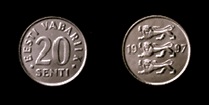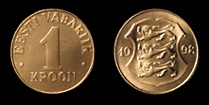The Estonian kroon (code: EEK; sign: kr) was the official currency of Estonia from 1928 to 1940, and again from 1992 to 2011. Between January 1 and January 14, 2011, the kroon circulated with the euro, which succeeded the kroon as the official currency of Estonia. It was divided into 100 senti (singular: sent). The word, kroon is related to that of Nordic currencies, such as the Swedish krona and the Danish and Norwegian krone, having been derived from the Latin word corona (meaning "crown"). It succeeded the mark in 1928, but was replaced by the Soviet ruble in 1940. After regaining its independence, Estonia introduced the kroon in 1992.
First kroon[]
History[]

The kroon was pegged to the Swedish krona.
The kroon became the official currency of Estonia on January 1, 1928, after being a unit of account since 1924. It replaced the mark at a rate of 100 mark = 1 kroon. The first kroon was divided into 100 senti.
During 1924, the kroon was pegged to the Swedish krona at par, having a gold standard of 2480 kroon = 1 kilogram of gold. This standard received actual coverage, with reserves backing the kroon's value. The issue of treasury notes and exchange notes in Estonia was ended. In order to secure credibility of the kroon, the Bank of Estonia (Eesti Pank) exchanged the kroon for foreign currency. These measures restored confidence in the domestic banking and monetary sector, helping with the economic reinvigeration of the country and the improvement of the country of Estonia in the international arena.
In 1933, during the Great Depression, the kroon was removed from the gold standard, devaluated 35%, and became pegged to the pound sterling (GBP) at a rate of 1 GBP = 18.35 krooni. The kroon retained this exchange rate and circulated until the Soviet Union invaded Estonia in 1940. During Soviet control, the kroon was exchanged for the ruble at a rate of 1 ruble = 0.8 krooni.
Banknotes and coins[]

The last coin minted before the Soviet takeover.
During 1928, the first coins of the kroon, nickel-bronze 25 sent coins, were issued. These were followed by bronze 1 sent coins in 1929, silver 2 kroon coins in 1930, bronze 5 sent and nickel-bronze 10 sent coins in 1931, silver 1 kroon coins in 1933, bronze 2 sent and aluminum-bronze 1 kroon coins in 1934, nickel-bronze 20 sent coins in 1935, and nickel-bronze 50 sent coins in 1936.
On July 25, 1940, 4 days after the founding of the Estonian Soviet Socialist Republic, the last coin of the first kroon, a new bronze 1 sent coin dated 1939, was produced.
In 1927, before the kroon was officially introduced, 100 mark banknotes were circulated with an overprint reading, "ÜKS KROON" (1 kroon). The Bank of Estonia introduced the 10 kroon banknote in 1928, followed by the 5 and 50 kroon banknotes in 1929, 20 kroon notes in 1932, and 100 kroon notes in 1935.
Second kroon[]
History[]
- For more information, see Estonian euro coins

The kroon was replaced by the euro in 2011.
On June 20, 1992, the kroon was reintroduced as Estonia's currency, replacing the Soviet ruble at a rate of 1 kroon = 10 rubles (each person was able to exchange a maximum of 1500 rubles to 150 krooni). Originally, the Estonian kroon was pegged to the Deutsche Mark (DEM) at a rate of 8 krooni = 1 DEM. After the euro's introduction in 1999, the fixed exchange rate of 1.95583 DEM to 1 EUR led to an exchange rate of 15.64664 krooni to 1 EUR. When Estonia joined the ERM II system on June 27, 2004, the central parity of the kroon was revalued (by less than 0.001%) to 15.6466 krooni equal to 1 euro. On January 1, 2011, the euro replaced the kroon as the currency of Estonia, though the kroon circulated alongside the euro until January 15, at which point it ceased to be legal tender. However, the Bank of Estonia will still exchange banknotes and coins of the kroon for those of the euro, without a set amount or time limit.
Banknotes[]
In 1992, banknotes were introduced in denominations of 1, 5, 10, 25, 100, and 500 kroons. Some of the 5, 10, 25, 100, and 500 kroon banknotes were dated 1991. During 1994, a new 50 kroon note was introduced. Unlike the other banknotes, the 1 and 50 kroon notes were issued once.
In 2008, the Bank of Estonia issued a commemorative banknote denominated at 10 krooni.
| Current Series | |||||||
| Image | Value | Color | Dimensions | Appearance | |||
| Obverse | Reverse | Obverse | Reverse | ||||

|

|
1 kroon | Orange/brown | 139 × 70 mm | Kristjan Raud | Toompea Castle | |

|

|
2 krooni | Gray-blue | 140 × 70 mm | Karl Ernst von Baer | University of Tartu | |

|

|
5 krooni | Orange | 139 × 69 mm | Paul Keres | Hermann Castle, Ivangorod Fortress | |

|

|
10 krooni | Red | 140 × 69 mm | Jakob Hurt | Tamme-Lauri oak tree | |

|

|
25 krooni | Green | 141 × 69 mm | Anton Hansen Tammsaare | Vargamäe | |

|

|
50 krooni | Dark green | 140 × 69 mm | Rudolf Tobias | Estonia Theatre | |

|

|
100 krooni | Light blue | 141 × 69 mm | Lydia Koidula | Baltic Klint | |

|

|
500 krooni | Purple | 140 × 69 mm | Carl Robert Jakobson | Barn Swallow | |
Coins[]
In 1992, coins of the second kroon were introduced (some dated 1991) in denominations of 5, 10, 20, and 50 senti, as well as 1 kroon. All of the coins were struck in aluminum-bronze, with an exception of the 1 kroon coin, which was composed of cupronickel. However, in 1997, a nickel plated steel 20 sent coin was introduced, followed by an aluminum-bronze 1 kroon coin in 1998. The 5 sent coin was not issued after 1994, but remained legal tender. The cupronickel 1 kroon coins of 1992, 1993, and 1995 stopped being legal tender on May 31, 1998. Along with these, a number of commemorative coins were introduced, in denominations of 1, 5, 10, 15.65, 25, 50, 100, and 500 krooni.
| General issue coinage | |||||
| Image | Value | Technical parameters | |||
| Diameter | Mass | Edge | Composition | ||

|
5 senti | 15.95 mm | 1.29 g | plain | Brass (93% Cu, 5% Al, 1% Ni) |

|
10 senti | 17.2 mm | 1.87 g | ||

|
20 senti | 18.95 mm | 2 g | Nickel plated steel | |

|
50 senti | 19.5 mm | 3 g | Brass (93% Cu, 5% Al, 1% Ni) | |

|
1 kroon | 23.25 mm | 5 g | reeded and plain | Nordic Gold (89% Cu, 5% Al, 5% Zn, 1% Sn) |
Exchange rates[]
| Current EEK exchange rates | |
|---|---|
| From Google Finance [1]: | AUD CAD CHF EUR GBP HKD JPY USD |
| From Yahoo! Finance [2]: | AUD CAD CHF EUR GBP HKD JPY USD |
| From OzForex [3]: | AUD CAD CHF EUR GBP HKD JPY USD |
| From XE.com [4]: | AUD CAD CHF EUR GBP HKD JPY USD |
| From OANDA.com [5]: | AUD CAD CHF EUR GBP HKD JPY USD |
See also[]
References[]
- ↑ European Central Bank, May 2010
| Banknotes | 1 kr • 2 kr • 5 kr • 10 kr • 20 kr • 25 kr • 50 kr • 100 kr • 500 kr |
|---|---|
| Coins | 1 s • 2 s • 5 s • 10 s • 20 s • 50 s • 1 kr • 2 kr • 5 kr • 10 kr • 15.65 kr • 25 kr • 50 kr • 100 kr • 500 kr |
| Miscellaneous | Bank of Estonia • Estonian euro coins • Soviet ruble |
| Pre-euro currencies |
|---|
